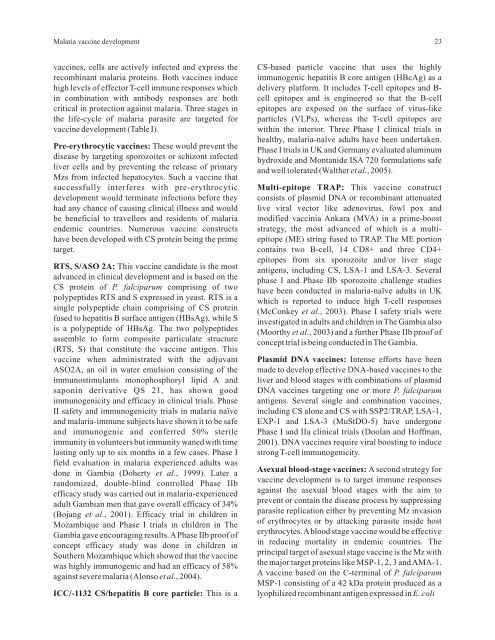PDF File - The Indian Society for Parasitology
PDF File - The Indian Society for Parasitology
PDF File - The Indian Society for Parasitology
Create successful ePaper yourself
Turn your PDF publications into a flip-book with our unique Google optimized e-Paper software.
Malaria vaccine development23vaccines, cells are actively infected and express the CS-based particle vaccine that uses the highlyrecombinant malaria proteins. Both vaccines induce immunogenic hepatitis B core antigen (HBcAg) as ahigh levels of effector T-cell immune responses which delivery plat<strong>for</strong>m. It includes T-cell epitopes and B-in combination with antibody responses are both cell epitopes and is engineered so that the B-cellcritical in protection against malaria. Three stages in epitopes are exposed on the surface of virus-likethe life-cycle of malaria parasite are targeted <strong>for</strong> particles (VLPs), whereas the T-cell epitopes arevaccine development (Table I).within the interior. Three Phase I clinical trials inhealthy, malaria-naïve adults have been undertaken.Pre-erythrocytic vaccines: <strong>The</strong>se would prevent thePhase I trials in UK and Germany evaluated aluminumdisease by targeting sporozoites or schizont infectedhydroxide and Montanide ISA 720 <strong>for</strong>mulations safeliver cells and by preventing the release of primaryand well tolerated (Walther et al., 2005).Mzs from infected hepatocytes. Such a vaccine thatsuccessfully interferes with pre-erythrocytic Multi-epitope TRAP: This vaccine constructdevelopment would terminate infections be<strong>for</strong>e they consists of plasmid DNA or recombinant attenuatedhad any chance of causing clinical illness and would live viral vector like adenovirus, fowl pox andbe beneficial to travellers and residents of malaria modified vaccinia Ankara (MVA) in a prime-boostendemic countries. Numerous vaccine constructs strategy, the most advanced of which is a multihavebeen developed with CS protein being the prime epitope (ME) string fused to TRAP. <strong>The</strong> ME portiontarget.contains two B-cell, 14 CD8+ and three CD4+epitopes from six sporozoite and/or liver stageRTS, S/ASO 2A: This vaccine candidate is the mostantigens, including CS, LSA-1 and LSA-3. Severaladvanced in clinical development and is based on thephase I and Phase IIb sporozoite challenge studiesCS protein of P. falciparum comprising of twohave been conducted in malaria-naïve adults in UKpolypeptides RTS and S expressed in yeast. RTS is awhich is reported to induce high T-cell responsessingle polypeptide chain comprising of CS protein(McConkey et al., 2003). Phase I safety trials werefused to hepatitis B surface antigen (HBsAg), while Sinvestigated in adults and children in <strong>The</strong> Gambia alsois a polypeptide of HBsAg. <strong>The</strong> two polypeptides(Moorthy et al., 2003) and a further Phase IIb proof ofassemble to <strong>for</strong>m composite particulate structureconcept trial is being conducted in <strong>The</strong> Gambia.(RTS, S) that constitute the vaccine antigen. Thisvaccine when administrated with the adjuvant Plasmid DNA vaccines: Intense ef<strong>for</strong>ts have beenASO2A, an oil in water emulsion consisting of the made to develop effective DNA-based vaccines to theimmunostimulants monophosphoryl lipid A and liver and blood stages with combinations of plasmidsaponin derivative QS 21, has shown good DNA vaccines targeting one or more P. falciparumimmunogenicity and efficacy in clinical trials. Phase antigens. Several single and combination vaccines,II safety and immunogenicity trials in malaria naïve including CS alone and CS with SSP2/TRAP, LSA-1,and malaria-immune subjects have shown it to be safe EXP-1 and LSA-3 (MuStDO-5) have undergoneand immunogenic and conferred 50% sterile Phase I and IIa clinical trials (Doolan and Hoffman,immunity in volunteers but immunity waned with time 2001). DNA vaccines require viral boosting to inducelasting only up to six months in a few cases. Phase I strong T-cell immunogenicity.field evaluation in malaria experienced adults wasdone in Gambia (Doherty et al., 1999). Later aAsexual blood-stage vaccines: A second strategy <strong>for</strong>randomized, double-blind controlled Phase IIbvaccine development is to target immune responsesefficacy study was carried out in malaria-experiencedagainst the asexual blood stages with the aim toadult Gambian men that gave overall efficacy of 34%prevent or contain the disease process by suppressing(Bojang et al., 2001). Efficacy trial in children inparasite replication either by preventing Mz invasionMozambique and Phase I trials in children in <strong>The</strong>of erythrocytes or by attacking parasite inside hostGambia gave encouraging results. A Phase IIb proof oferythrocytes. A blood stage vaccine would be effectiveconcept efficacy study was done in children inin reducing mortality in endemic countries. <strong>The</strong>Southern Mozambique which showed that the vaccineprincipal target of asexual stage vaccine is the Mz withwas highly immunogenic and had an efficacy of 58%the major target proteins like MSP-1, 2, 3 and AMA-1.against severe malaria (Alonso et al., 2004).A vaccine based on the C-terminal of P. falciparumMSP-1 consisting of a 42 kDa protein produced as aICC/-1132 CS/hepatitis B core particle: This is a lyophilized recombinant antigen expressed in E. coli










